BEIJING
Beijing has been the capital of the People’s Republic of China since construction of the Forbidden City was completed in 1420. The first emperor to rule from Beijing was the third Ming emperor, Yongle. All subsequent Ming and Qing dynasty emperors ruled from the Forbidden City in the center of Beijing. Beijing remains the capital today.
Beijing has a population of more than 14 million making it one of the world’s largest cities. Much of China’s history and tradition can be experienced in and around Beijing, but it is also a rapidly changing city.
Traditional Beijing was developed around the Forbidden City – the palace from which the final two dynasties ruled. The rest of the city was developed in rings around that core. There are historic temples and palaces as well as simple hutong (old traditional courtyard houses). All of this traditional development emanates from the core of the Forbidden City.
Modern Beijing is urban chaos. There is constant construction to try to house 14 million people; however, most of the current construction is in preparation for the 2008 Olympics which will be centered in Beijing (the games will actually be widely spread about the country). There are countless high-rise construction cranes as far as one can see in all directions. It is quite remarkable.
Although bicycles are still the primary mode of transportation in Beijing, there are far more cars on the roads than their infrastructure can handle. The traffic situation is dreadful, but even worse is the pollution. The air is not fit to breathe. It is common to see the local population wearing surgical masks in an attempt to get some relief from the pollution. Buildings two blocks away are lost in the haze.
But Beijing holds a tremendous amount of interest for the visitor, and it is where we began our tour.
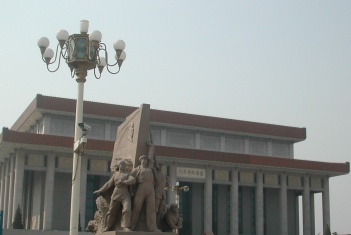
Mao’s mausoleum
Tianamen Square, built on Mao’s orders, is a vast concrete expanse just south of the Forbidden City. It is more than 300 yards wide and 1,000 yards long. It is intended to hold at least 1 million people.
At the southern end are two towers that were part of the wall that once surrounded Beijing. These were built in the Ming dynasty. The first tower – Jian Lou – is the outer gate. The more northern tower – Qian Men – now houses a museum of the history of Beijing.
Mao’s mausoleum is at the center of the square, and it is massive. Mao’s casket is on display a few days per week (one must wait in line for hours to get in to see it), and it is lowered in to a refrigerated chamber when not on display. Massive statues of revolutionaries are at both sides of the mausoleum entrance, and a military guard is always on duty.
The Monument to the People’s Heroes is nearby. It is a granite obelisk decorated with writings of Mao and Zhou Enlai.
The national flag is at the northern end of the square. Otherwise, the square is open, and there are thousands of people in the square at any given time.
It was an unsettling place to begin our tour. Tianamen means Gate of Heavenly Peace; however, we both well remember the events in the square in 1989 – neither heavenly nor peaceful. We wanted to ask, “Where did the tanks come in?”, but we knew not to. We took a few pictures and headed for the Forbidden City – just to the north.
The Forbidden City was a huge palace built during the Ming dynasty and completed in 1420. Twenty four emperors ruled from the Forbidden City over nearly 500 years. It has been open to the public since 1949.
The Forbidden City measures approximately 1,300 yards in a north-south direction and 1,000 yards in an east-west direction – more than four times the vast expanse of Tianamen Square. It is fully enclosed within a 35 foot tall wall, and arrow towers are at each corner. Beyond the wall is a 20 foot deep moat, and there was previously a second Imperial City wall which has not survived. There are 9,999 rooms within the Forbidden City.
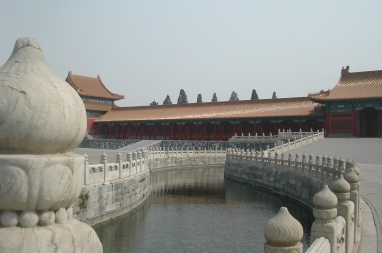
Moat inside Forbidden City
The entrance to the Forbidden City is from the south, and one enters through ornate gates and over marble bridges in to the Outer Court. The Outer Court – approximately 300 yards wide and 1,000 yards long – was the center of business within the Forbidden City, and it is comprised of offices, storehouses, and, of course, regal halls. Beyond the Outer Court are the various palaces, halls, and courtyards which were the living quarters for the emperor, his family, and his concubines.
The grandeur of the Forbidden City must be seen to be believed. The ornate architecture is characteristic of the Ming dynasty with the upturned eaves and brightly colored décor. It is a spectacular sight.
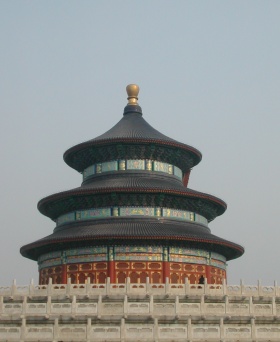
Temple of Heaven
The Temple of Heaven, a few miles away from the Forbidden City, is a beautiful example of architectural balance and symbolism characteristic of the Ming dynasty. The temple itself is round and sits atop three circular tiers of marble that are 300 feet in diameter and 20 feet high. The décor inside the temple is gilded and highly ornate. This is where the emperor – the Son of Heaven – came to pray and make sacrifices at the winter solstice.
The Summer Palace, built on a hill six miles northwest of Beijing, provided a retreat from the heat in Beijing during the summer months. The grounds of the Summer Palace cover 716 acres and include three lakes.
Although the Summer Palace was a retreat to numerous emperors, it is most closely associated with Empress Dowager Cixi. Cixi was a royal concubine of Emperor Xianfeng, and she bore him a son. Her young son was to become the emperor; however, he was dominated by Cixi, and she essentially ruled from “behind the screen”. Her influence continued when her young nephew became emperor, and her rule has been largely blamed for the end of the dynasties in China. Cixi, often called “the dragon lady” in China is widely disliked.
The Great Wall began as separate earthen barriers designed to repel invaders from the north. During the rule of Emporer Qin Shi Huang (221-210 BC), many of these barriers were connected; however, the wall was breached in the 13th century by the Mongols. In the 16th century, during the Ming dynasty, the wall was substantially redesigned and reinforced. All wall sections were joined, and the wall became a continuous structure for more than 1,500 miles over mountains, deserts, and plains. However, it was breached again in the 17th century by the Manchus.
Today, most of the wall is crumbling, and visits are made only to those sites that have been restored. We visited the wall at Juyong Guan where it is thoroughly restored. We climbed for a few hours with occasional stops to enjoy the views from various towers. The wall continued up and over the mountainous terrain as far as we could see.
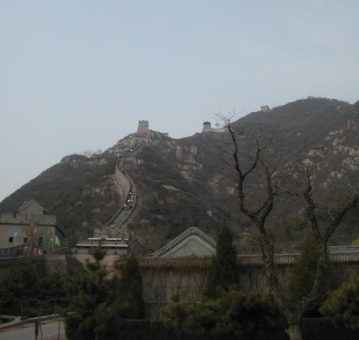
Climbing the Great Wall
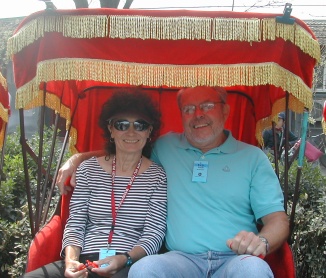
Our ‘surrey with the fringe on top’
The hutong is a traditional type of residential neighborhood comprised of courtyard houses along narrow alleyways. The hutong have been razed for high rise developments, and they almost disappeared from Beijing a few years ago. However, someone realized that they had value in tourist dollars, and a few were saved.
As with most Chinese building, the features of the courtyard houses are rich in symbolism. The entrances are at the southeastern corner as dictated by feng shui. At the entrance there are transoms to be stepped over (but never stepped on), and the height of the transom is an indication of the status of the residents. There are walls just inside the entrance that prevent spirits from entering (spirits cannot turn corners). The number of halls and courtyards within are a further indication of status.
We toured a hutong by rickshaw. Today’s rickshaws are bicycle powered, but they still require considerable physical effort by the driver. We had tea at the home of Mr. Fong who told us (via interpreter) about his family’s history in the hutong and why his family continues to live there. It was a considerable readjustment from the grandeur of the palaces and temples we had been visiting, but it was also a worthwhile visit. It was an opportunity to see a bit of today’s working person’s life.
Long Di Superior Jade Factory – We had the misfortune to visit the state run jade factory near Juyong Guan as we were returning to Beijing from the Great Wall. It was interesting to learn about jade and watch some carved and polished, but the sales people were pushy and overbearing. We would have liked to have looked at a few items and possibly bought a few things, but the sales clerk prevented us from finding the few things we were interested in. A bad experience.
Beijing Acrobats Show – This was an evening performance in a local theater, and the acrobats were wonderful. The theater was a bit run down, and the show sorely lacked production, but the acrobats themselves more than made up for any production weaknesses. Remarkable athletes.
Martial Arts ‘Kung Fu’ Show – This, too, was an evening performance in another local theater. The show revolved around a story of a young boy being raised by Shaolin monks whom were kung fu masters. The story was trite, but the martial arts performers were excellent. Also, the theater and production were both better than that of the acrobats show.
When we left Beijing, we flew to Xian – the capital of Shaanxi province.